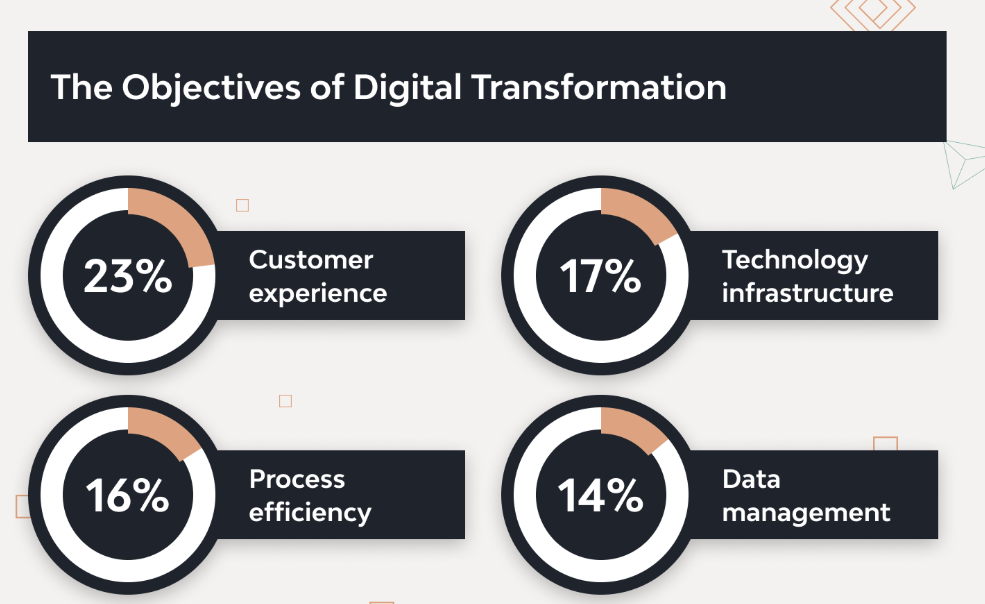Digital business transformation: where to start in 2025
.jpg)
Digital business transformation: where to start in 2025
We are used to repeating that digital business transformation is the number one task. At every conference, we are told that businesses must keep up with the times. Digitize or close the doors and go home. It sounds solid, fashionable, hype.
But for many entrepreneurs, digitalization is still a very vague concept. What is this? Artificial intelligence, blockchain, and predictive analytics? Or is it just a transition from traditional management tools to new solutions? It's hard to say for sure.

Therefore, we will consider the concept of digital transformation in combination and in simple words. We will identify real methods and problem areas, analyze cases from different industries and compile a checklist for a quick start.
What is digital transformation in simple terms?
If we omit pathos and loud words, then The digitalization of the company means the use of modern electronic tools in familiar work processes.
A few examples:
- contract management in a cloud platform with a digital signature function;
- analysis of customer preferences using CRM rather than employee surveys;
- maintaining automated dashboards to assess marketing effectiveness in real time.
It is important to understand that digitalization is a gradual process. It doesn't break the foundations of your business or build new ones on ruins. The transition is smooth, one step at a time. Today you enter customer data into an electronic database, tomorrow your sales managers use the generated lead phrases, and the day after tomorrow, artificial intelligence classifies calls.
There is no shock, no staff outflow, no critical mistakes. Before moving on to the next step, you test and debug the current one.
Smooth digitalization starts small:
- the coffee shop switches to a QR menu that helps collect statistics;
- the construction company transfers the project via a cloud drive;
- the logistics operator tracks cars via GPS.
Digitalizing small businesses is not about subscribing to software products. This is a change of mind. The company is learning how to adapt to new conditions, make decisions based on data, and teamwork on improvement.
The stages of digital transformation
The main mistake in digitalization is haste. Many companies immediately grab on to fancy tools or copy their competitors' solutions. This is usually of no use.
The right approach is individual. You need to build your workflow and find the tools that are right for you. So it all starts with determining the current situation.
In the table below, we'll look at digital transformation steps, popular tools, results, and short examples:

If you are interested in how to start digitalization, check out this table. Be sure to note that it gives a clear sequence of actions. An audit will help you determine the current situation and identify the most important problems, strategic planning will help you choose priority areas for development, implementation will help you get concrete results, and staff training will consolidate achievements.
This is a clear process. By following this sequence, you will achieve maximum efficiency, reduce resistance and reduce the likelihood of a pullback to previous positions.
Main barriers and block factors
Any change is met with resistance. It's just like physics: to set the system in motion, you have to overcome friction and inertia. In this case, the resistance factors will be:
- Lack of measurable goals. If you don't know what company digitalization is and why you need it, a clear route turns into chaotic traffic. Before changing workflows, you must set specific goals: reduce document processing time by 50%, increase service satisfaction by half, and reduce costs by 15%.

- Technical restrictions. The new CRM might not run on an old server, and cloud platforms might not run on Windows XP. First, you need to familiarize yourself with the system requirements and, if necessary, allocate time to pre-prepare the infrastructure.
- Erroneous estimates. Some entrepreneurs are refusing digital transformation, considering it an expensive process. But in fact, every expensive product has simple analogues available. Instead of Big Data, you can start with Excel spreadsheets; instead of multifunctional platforms, you can start with Google Analytics.
- Lack of expertise. By blindly copying well-known examples of digitalization, you will end up with a confusing, inefficient system. You should start from the bottom and go from problem to solution, from goal to tool, clearly understanding each action. This is harder and longer, but much more effective.
- Employee resistance. It is found in almost every case. Employees perceive innovations as an additional burden, sabotaging the process. To mitigate resistance, we need to show the real benefits of digital transformation for ordinary employees, not businesses.
Brief cases from various industries
To consolidate the theoretical part, let's move on to practice. Next, let's look at the most striking and convincing digital transformation cases on a global scale:
- Walmart. The retail giant has entrusted the analysis of online and offline sales to artificial intelligence. The predictive system helped optimize the volume of orders. It reduced the number of insufficient and redundant positions by 20%.
- JPMorgan Chase. The bank has entrusted communication with customers to smart chatbots that can identify unique patterns of behavior. The number of fraudulent transactions decreased by 25%, and the user retention rate increased by 15%.
- Uber. The service combined navigation, pricing and ordering systems into one complex with support for artificial intelligence. The average profitability of a trip increased by 10% due to lower fuel consumption, cost optimization and reduced customer churn.
- General Electric. The manufacturing company has created its own Predix system, which predicts the time of the next equipment failure. Preventive repairs reduced conveyor downtime by 50— 75%.
- Cleveland Clinic. A network of clinics has created an application that collects data from patients' mobile devices and receives information from a smart home. It was able to improve the accuracy of diagnoses due to indirect signs.
Checklist: How to start digital transformation
Having considered examples, we can definitely say that digitalization is necessary if it is carried out correctly. So that you don't get confused about this process, we have prepared the Digital Transformation 2025 checklist:
- Conduct an audit. Identify bottlenecks and pain points. Look at competitors and market leaders. Identify priorities and opportunities.
- Set strategic goals. Write down the 2-3 numbers you want to achieve. Think about how you can come to them. Build a roadmap.
- Pick up tools. Each of them must be tailored to a specific task. Follow the principle of minimization. If one program solves several problems, choose it over several others.
- Engage employees. Start by demonstrating the benefits. Show that new solutions will make their lives easier. Conduct training and test several practical cases in a real work environment.
- Launch a pilot project. This may be one process, one workplace or one direction. Evaluate the first results — time, costs, quality. Adjust as needed.
- Scale. Use successful practices across the company. Gather feedback and get ready for the next level of transformation that will help you achieve even better results.

In ideal cases, business digitalization supports itself. The entrepreneur sets strategic goals, shows employees the real benefits of new technologies, appoints those responsible and controls the process. The less work you do manually, the more likely digitalization is to produce positive results.
FAQ
What does digital transformation involve?
This is an update of the company's key processes using technology. It covers strategy, products, sales channels, and customer relations.
How to start digitalizing the company?
From an audit, identify weaknesses and priority areas. Then create a strategy and select a pilot project.
How does digitalization differ from automation?
Automation solves specific problems, for example, document management. Digitalization is a comprehensive restructuring of the business model and work processes.
How much does it cost to digitalize a business?
The amount depends on the scale and industry. This is hundreds of dollars for an individual entrepreneur, several thousand for a small company, and millions for corporations.
What mistakes do companies make when transforming digitally?
Companies launch projects that are too ambitious without pilots, ignore staff training and thoughtlessly copy others' decisions.

